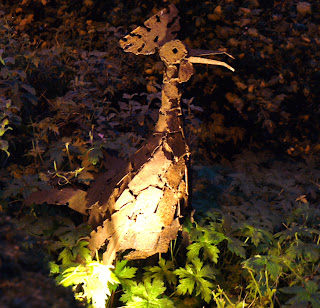.
Many ornamental plants are also edible.
.
Encouragement from the top?
The blog of Steve Rice, Blooming Good Gardens, a garden designer based in the New Forest, near Southampton, covering Hampshire, East Dorset and East Wiltshire.







 which retains a low mound of arching basal leaves and holds the faded flower heads aloft on wiry stems through the worst of gales, to wave around in gentler breezes, looking delightful against even a winter sky, or a reflection of that sky in a still pool. Grass-like perennials such as Dierama and even some of the Irises & Kniphofias can be used to similar effect.
which retains a low mound of arching basal leaves and holds the faded flower heads aloft on wiry stems through the worst of gales, to wave around in gentler breezes, looking delightful against even a winter sky, or a reflection of that sky in a still pool. Grass-like perennials such as Dierama and even some of the Irises & Kniphofias can be used to similar effect. 
Trees...
There aren’t too many trees (other than conifers, of which there are a great many forms & colours) which are reliably evergreen in our climate, the main ones being Acacia dealbata (Mimosa), Arbutus (Strawberry Tree), Cordyline (Cabbage Palm), Eucalyptus (Gum Trees), Ilex (Holly), Ligustrum lucidum (Chinese Privet), Luma apiculata (Myrtle family), Magnolia grandiflora, Pittosporum, Prunus laurocerasus or Prunus lusitanica (Laurel), and Quercus ilex (Holm Oak) – though, of these, all but the Holly will only succeed in sheltered aspects in the milder parts of southern England and many are very slow growing, more often regarded as shrubs or hedging than trees.





So why’s it so good?
Secondly, the practicalities: The book itself is convenient A5 size, and spiral-bound, so it lays flat within a very small footprint on your desk, or even held in one hand, while guiding your mouse with the other. It includes colour screen images or sections of them throughout, which are well-positioned to match the text. There’s a CD which holds both a PDF copy of the book and a set of Vectorworks files which constitute the sample project at various stages within the workflow and exercise files so that you can try things out without screwing up the project files.
After completing this book and project, the 3D features of Vectorworks/Landmark are completely de-mystified and just make sense as the natural way of working with the package – I found that I could easily work through my current design project alongside the book’s sample project and gain all the benefits and efficiencies which I’d been missing out on. I’m not saying that the supplied Vectorworks manuals aren't useful, but they are descriptive of what the various tools do, not how they are applied, and they seem to be written by “techies” not practitioners – which left me using only a fraction of the package in the 12-months-plus which I’d employed it. Not any more!
I do have some criticisms – there are a lot of “typos” which a better proof-reading should have found, though usually these don’t impact on comprehension. The screen-image clips are very small – presumably to keep the physical size of the book down – which is fine if you’re just using them as a visual cue to what you’re seeing on your screen as you work through the project, but sometimes they make using the book for reference difficult - unless you have much more acute vision than me.
My major criticism is that the book has no index, so to use it for reference you either have to thumb through the contents pages, which list topics within the workflow of the sample project, and then skip-read through that section; or you have to resort to the PDF copy and use Adobe reader’s “find” facilities to locate the item you need. The sample project is “split-level”, so the book does cover retaining walls, steps, raised beds and so on, but it doesn’t cover site modelling of a “real” situation where there are undulating contours and how to construct a design over this. Nor does it discuss “real” hardscape which has a rainwater run-off gradient. Perhaps these might be the subject of a future “advanced” landscape design book.
Conclusions:
Would I recommend this book? Wholeheartedly and without reservation!
Who would benefit from this book? Students of Garden Design or experienced designers who are new to Vectorworks, and those people, like me, who are experienced users of Vectorworks but who’ve shied away from some of the most productive parts of the package because they seemed “too difficult”.
One final word of caution – make sure you have the appropriate version of the Vectorworks software - the book is for Vectorworks 2009, so you can’t read the exercise and sample project files if you’re running Vectorworks 2008 or below, though you could possibly manage with a 2009 demo version on another machine. If you’re lucky enough to have Vectorworks 2010, it should work OK, but I presume there’s a revision or new edition coming along to pick up on the enhanced 2010 features.
Steve Rice, Blooming Good Gardens, Southampton, UK
 The lamps used can either be mains voltage or low voltage - using weather-proof transformers located near to the string of luminaires to step down the mains to a level (typically 12v or 24v) which is safe even if you accidentally chop through a cable whilst gardening. They will usually be one of 3 types depending on their purpose – most commonly tungsten-halogen (similar to those used in kitchen ceiling downlights) which offer a very wide range of light output (wattage) and beam spread, and can also be faded up & down with suitable equipment. The second type, LED lamps, are highly efficient and stay cool, so they are especially useful in situations such as deck lights or other places where accidental contact with people or animals is a possibility; they also have a very long lifetime and can give out blue, amber, red & green light as well as white light - devices are available to mix the light colours to provide an infinitely variable range of hues which can even be changed to match the mood or occasion, or can be programmed to create varying colour light shows for parties. The third main type is metal-halide lamps which give out high-powered, intense light used for the uplighting of large trees or faces of buildings.
The lamps used can either be mains voltage or low voltage - using weather-proof transformers located near to the string of luminaires to step down the mains to a level (typically 12v or 24v) which is safe even if you accidentally chop through a cable whilst gardening. They will usually be one of 3 types depending on their purpose – most commonly tungsten-halogen (similar to those used in kitchen ceiling downlights) which offer a very wide range of light output (wattage) and beam spread, and can also be faded up & down with suitable equipment. The second type, LED lamps, are highly efficient and stay cool, so they are especially useful in situations such as deck lights or other places where accidental contact with people or animals is a possibility; they also have a very long lifetime and can give out blue, amber, red & green light as well as white light - devices are available to mix the light colours to provide an infinitely variable range of hues which can even be changed to match the mood or occasion, or can be programmed to create varying colour light shows for parties. The third main type is metal-halide lamps which give out high-powered, intense light used for the uplighting of large trees or faces of buildings. 
